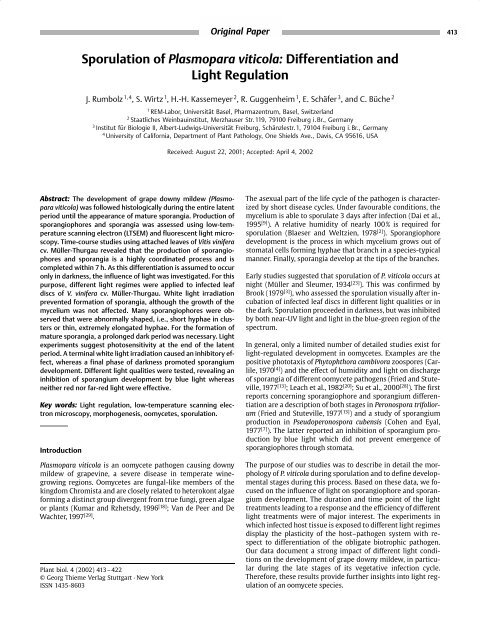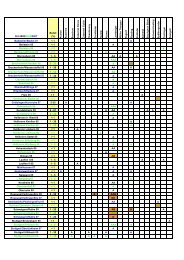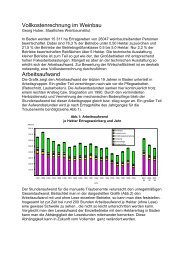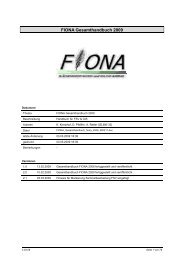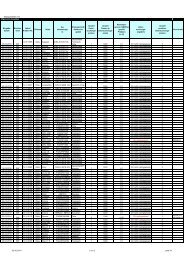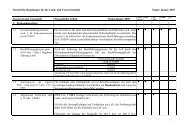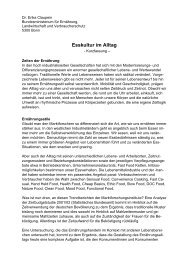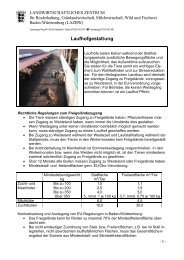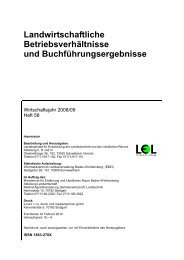Sporulation of Plasmopara viticola: Differentiation and Light ...
Sporulation of Plasmopara viticola: Differentiation and Light ...
Sporulation of Plasmopara viticola: Differentiation and Light ...
Create successful ePaper yourself
Turn your PDF publications into a flip-book with our unique Google optimized e-Paper software.
Abstract: The development <strong>of</strong> grape downy mildew �<strong>Plasmopara</strong><br />
<strong>viticola</strong>) was followed histologically during the entire latent<br />
period until the appearance <strong>of</strong> mature sporangia. Production <strong>of</strong><br />
sporangiophores <strong>and</strong> sporangia was assessed using low-temperature<br />
scanning electron �LTSEM) <strong>and</strong> fluorescent light microscopy.<br />
Time-course studies using attached leaves <strong>of</strong> Vitis vinifera<br />
cv. Müller-Thurgau revealed that the production <strong>of</strong> sporangiophores<br />
<strong>and</strong> sporangia is a highly coordinated process <strong>and</strong> is<br />
completed within 7h. As this differentiation is assumed to occur<br />
only in darkness, the influence <strong>of</strong> light was investigated. For this<br />
purpose, different light regimes were applied to infected leaf<br />
discs <strong>of</strong> V. vinifera cv. Müller-Thurgau. White light irradiation<br />
prevented formation <strong>of</strong> sporangia, although the growth <strong>of</strong> the<br />
mycelium was not affected. Many sporangiophores were observed<br />
that were abnormally shaped, i.e., short hyphae in clusters<br />
or thin, extremely elongated hyphae. For the formation <strong>of</strong><br />
mature sporangia, a prolonged dark period was necessary. <strong>Light</strong><br />
experiments suggest photosensitivity at the end <strong>of</strong> the latent<br />
period. A terminal white light irradiation caused an inhibitory effect,<br />
whereas a final phase <strong>of</strong> darkness promoted sporangium<br />
development. Different light qualities were tested, revealing an<br />
inhibition <strong>of</strong> sporangium development by blue light whereas<br />
neither red nor far-red light were effective.<br />
Key words: <strong>Light</strong> regulation, low-temperature scanning electron<br />
microscopy, morphogenesis, oomycetes, sporulation.<br />
Introduction<br />
<strong>Plasmopara</strong> <strong>viticola</strong> is an oomycete pathogen causing downy<br />
mildew <strong>of</strong> grapevine, a severe disease in temperate winegrowing<br />
regions. Oomycetes are fungal-like members <strong>of</strong> the<br />
kingdom Chromista <strong>and</strong> are closely related to heterokont algae<br />
forming a distinct group divergent from true fungi, green algae<br />
or plants �Kumar <strong>and</strong> Rzhetsdy, 1996 [18] ; Van de Peer <strong>and</strong> De<br />
Wachter, 1997 [29] .<br />
Original Paper<br />
<strong>Sporulation</strong> <strong>of</strong> <strong>Plasmopara</strong> <strong>viticola</strong>: <strong>Differentiation</strong> <strong>and</strong><br />
<strong>Light</strong> Regulation<br />
J. Rumbolz 1, 4 , S. Wirtz 1 , H.-H. Kassemeyer 2 , R. Guggenheim 1 , E. Schäfer 3 , <strong>and</strong> C. Büche 2<br />
1 REM-Labor, Universität Basel, Pharmazentrum, Basel, Switzerl<strong>and</strong><br />
2 Staatliches Weinbauinstitut, Merzhauser Str.119, 79100 Freiburg i.Br., Germany<br />
3 Institut für Biologie II, Albert-Ludwigs-Universität Freiburg, Schänzlestr.1, 79104 Freiburg i.Br., Germany<br />
4 University <strong>of</strong> California, Department <strong>of</strong> Plant Pathology, One Shields Ave., Davis, CA 95616, USA<br />
Plant biol. 4 �2002) 413±422<br />
Georg Thieme Verlag Stuttgart ´ New York<br />
ISSN 1435-8603<br />
Received: August 22, 2001; Accepted: April 4, 2002<br />
The asexual part <strong>of</strong> the life cycle <strong>of</strong> the pathogen is characterized<br />
by short disease cycles. Under favourable conditions, the<br />
mycelium is able to sporulate 3 days after infection �Dai et al.,<br />
1995 [9] ). A relative humidity <strong>of</strong> nearly 100% is required for<br />
sporulation �Blaeser <strong>and</strong> Weltzien, 1978 [2] ). Sporangiophore<br />
development is the process in which mycelium grows out <strong>of</strong><br />
stomatal cells forming hyphae that branch in a species-typical<br />
manner. Finally, sporangia develop at the tips <strong>of</strong> the branches.<br />
Early studies suggested that sporulation <strong>of</strong> P. <strong>viticola</strong> occurs at<br />
night �Müller <strong>and</strong> Sleumer, 1934 [23] ). This was confirmed by<br />
Brook �1979 [3] ), who assessed the sporulation visually after incubation<br />
<strong>of</strong> infected leaf discs in different light qualities or in<br />
the dark. <strong>Sporulation</strong> proceeded in darkness, but was inhibited<br />
by both near-UV light <strong>and</strong> light in the blue-green region <strong>of</strong> the<br />
spectrum.<br />
In general, only a limited number <strong>of</strong> detailed studies exist for<br />
light-regulated development in oomycetes. Examples are the<br />
positive phototaxis <strong>of</strong> Phytophthora cambivora zoospores �Carlile,<br />
1970 [4] ) <strong>and</strong> the effect <strong>of</strong> humidity <strong>and</strong> light on discharge<br />
<strong>of</strong> sporangia <strong>of</strong> different oomycete pathogens �Fried <strong>and</strong> Stuteville,<br />
1977 [13] ; Leach et al., 1982 [20] ; Su et al., 2000 [28] ). The first<br />
reports concerning sporangiophore <strong>and</strong> sporangium differentiation<br />
are a description <strong>of</strong> both stages in Peronospora trifoliorum<br />
�Fried <strong>and</strong> Stuteville, 1977 [13] ) <strong>and</strong> a study <strong>of</strong> sporangium<br />
production in Pseudoperonospora cubensis �Cohen <strong>and</strong> Eyal,<br />
1977 [7] ). The latter reported an inhibition <strong>of</strong> sporangium production<br />
by blue light which did not prevent emergence <strong>of</strong><br />
sporangiophores through stomata.<br />
The purpose <strong>of</strong> our studies was to describe in detail the morphology<br />
<strong>of</strong> P. <strong>viticola</strong> during sporulation <strong>and</strong> to define developmental<br />
stages during this process. Based on these data, we focused<br />
on the influence <strong>of</strong> light on sporangiophore <strong>and</strong> sporangium<br />
development. The duration <strong>and</strong> time point <strong>of</strong> the light<br />
treatments leading to a response <strong>and</strong> the efficiency <strong>of</strong> different<br />
light treatments were <strong>of</strong> major interest. The experiments in<br />
which infected host tissue is exposed to different light regimes<br />
display the plasticity <strong>of</strong> the host±pathogen system with respect<br />
to differentiation <strong>of</strong> the obligate biotrophic pathogen.<br />
Our data document a strong impact <strong>of</strong> different light conditions<br />
on the development <strong>of</strong> grape downy mildew, in particular<br />
during the late stages <strong>of</strong> its vegetative infection cycle.<br />
Therefore, these results provide further insights into light regulation<br />
<strong>of</strong> an oomycete species.<br />
413
414<br />
Plant biol. 4 �2002) J. Rumbolz et al.<br />
Materials <strong>and</strong> Methods<br />
Plant <strong>and</strong> fungal material<br />
Two-node cuttings <strong>of</strong> grapevine �Vitis vinifera L. cv. Müller-<br />
Thurgau) were rooted in pots <strong>and</strong> grown in the greenhouse under<br />
a natural photoperiod until shoots reached a length <strong>of</strong><br />
40 cm. Plants were kept free from powdery mildew infections<br />
by vaporization <strong>of</strong> sulphur for 5 h per day. For all experiments,<br />
the fifth or sixth exp<strong>and</strong>ed leaf <strong>of</strong> each plant, counted from the<br />
apex, was used. Leaf discs were prepared after surface sterilization<br />
with a tissue wipe soaked with 75 % ethanol <strong>and</strong> subsequent<br />
rinsing in distilled water. Discs were excised with a cork<br />
borer �diameter 16 mm) <strong>and</strong> placed onto water agar �0.8 %) in<br />
petri dishes. In additional experiments, leaf discs were also<br />
placed on water agar containing 2 % sucrose.<br />
<strong>Plasmopara</strong> <strong>viticola</strong> �Berk. <strong>and</strong> Curt.) Berl. <strong>and</strong> De Toni was<br />
obtained from a natural field infection <strong>and</strong> maintained on<br />
cuttings <strong>of</strong> V. vinifera cv. Müller-Thurgau �see above) in the<br />
greenhouse. Propagation <strong>of</strong> the pathogen was carried out by<br />
misting abaxial leaf sides <strong>of</strong> cuttings with a spore suspension<br />
�20 000 sporangia ml ±1 distilled water) until run-<strong>of</strong>f, <strong>and</strong> covering<br />
<strong>of</strong> entire plants with wet polyethylene bags overnight.<br />
Bags were removed on the following day <strong>and</strong> plants were kept<br />
in the greenhouse for 5 ± 6 days, corresponding to the latent<br />
period <strong>of</strong> P. <strong>viticola</strong>,at20±268C. Another overnight incubation<br />
<strong>of</strong> inoculated plants under the wet plastic bag yielded new<br />
sporangia. Fresh inoculum was harvested with a paintbrush<br />
into centrifuge tubes. To prepare spore suspensions used in<br />
the experiments, sporangia were counted using a Fuchs±Rosenthal<br />
counting chamber <strong>and</strong> diluted to a final concentration<br />
<strong>of</strong> 20 000 sporangia ml ±1 .<br />
<strong>Sporulation</strong> experiments<br />
To observe the morphogenesis <strong>of</strong> P. <strong>viticola</strong> during sporulation,<br />
attached leaves <strong>of</strong> cuttings <strong>of</strong> V. vinifera �cv. Müller-Thurgau)<br />
were inoculated by misting the abaxial leaf surface with a<br />
spore suspension until run-<strong>of</strong>f. Plants were covered overnight<br />
with wet polyethylene bags. Bags were removed on the following<br />
day <strong>and</strong> plants were kept in the greenhouse under the natural<br />
photoperiod. <strong>Sporulation</strong> was induced after 6 days by covering<br />
the entire plants with wet polyethylene bags <strong>and</strong> transferring<br />
them to darkness at dusk �8 p.m.). To monitor the time<br />
course <strong>of</strong> sporulation, infected leaves were detached <strong>and</strong> areas<br />
with downy mildew lesions were cry<strong>of</strong>ixed in liquid nitrogen<br />
at hourly intervals until the following morning �6 a.m.). Samples<br />
were further prepared for low-temperature scanning<br />
electron microscopy �LTSEM) studies, as described below. All<br />
experiments were carried out between April <strong>and</strong> June <strong>and</strong> repeated<br />
in triplicate.<br />
<strong>Light</strong> experiments<br />
Leaf discs placed on water agar were inoculated abaxially with<br />
a100-ml droplet <strong>of</strong> a spore suspension. Petri dishes were sealed<br />
in order to avoid desiccation <strong>of</strong> the inoculation droplet <strong>and</strong> incubated<br />
at 22 8C ambient temperature. To apply short-day conditions,<br />
samples were incubated in growth chambers, immediately<br />
after inoculation, with an irradiation <strong>of</strong> WL �300 mmol<br />
m ±2 s ±1 , 10 Osram HQIL 400 W-lamps plus four Osram L40/<br />
W60 fluorescent bulbs; Osram, Berlin, Germany) for 8 h <strong>and</strong> a<br />
dark period <strong>of</strong> 16 h �Schäfer, 1975 [26] ). Continuous white light<br />
�cWL, 80 mmol m ±2 s ±1 ) <strong>and</strong> continuous monochromatic irradiation<br />
<strong>of</strong> blue light �436 nm, 38.5 mmol m ±2 s ±1 ), red light<br />
�656 nm, 3 mmol m ±2 s ±1 ) <strong>and</strong> far-red light �730 nm, 14 mmol<br />
m ±2 s ±1 ) was applied as previously described in Schäfer<br />
�1977 [27] ).<br />
To determine the time course <strong>of</strong> sporangium differentiation in<br />
leaf disc experiments under short-day, constant darkness <strong>and</strong><br />
white light conditions, each sample consisted <strong>of</strong> 5 leaf discs<br />
per petri dish. Discs were harvested at various time points between<br />
68 <strong>and</strong> 98 h post-inoculation �p.i.) <strong>and</strong> either transferred<br />
into 50 ml <strong>of</strong> 1M KOH for light microscopy or cry<strong>of</strong>ixed in<br />
liquid nitrogen for LTSEM. Assessment <strong>of</strong> pathogen development<br />
was made with light <strong>and</strong> fluorescence microscopy, as described<br />
below, as well as with scanning electron microscopy.<br />
Experiments were repeated in triplicate.<br />
In light experiments, where inoculated leaf discs �5 discs per<br />
experiment, petri dish <strong>and</strong> variant) were exposed to white<br />
light <strong>and</strong> kept in darkness for different time intervals �see<br />
Figs. 4,6±8 for irradiation schedules), incubation was terminated<br />
88 h p.i. Experiments were repeated in triplicate. Assessment<br />
<strong>of</strong> sporangiophore <strong>and</strong> sporangium development was<br />
done by light <strong>and</strong> epifluorescence microscopy, as described<br />
below.<br />
<strong>Light</strong> <strong>and</strong> epifluorescence microscopy<br />
Leaf discs transferred to KOH after various incubation periods<br />
were cleared by autoclaving the samples for 15 min. After cooling<br />
down, KOH was decanted <strong>and</strong> samples were washed three<br />
times in 50 ml distilled water. 0.05% Aniline blue �Merck,<br />
Darmstadt, Germany) was dissolved in 0.067 M K 2HPO 4 pH<br />
9.0 <strong>and</strong> used to stain intercellular hyphae, as well as fungal<br />
structures <strong>of</strong> P. <strong>viticola</strong> which protruded from stomata <strong>of</strong> the<br />
host epidermis �Williamson et al., 1995 [30] ).<br />
Cleared <strong>and</strong> stained leaf discs were examined by light �bright<br />
field) <strong>and</strong> epifluorescence microscopy using an Axiophot<br />
�Zeiss, Oberkochen, Germany) microscope equipped with an<br />
epifluorescence device �excitation at 365 nm; LP 397 nm). For<br />
microscopic analyses, a leaf area encircled by leaf veinlets was<br />
defined as a ªleaf unitº �Fig.1A). 20±25 leaf units per leaf disc<br />
exhibiting tissue colonized by P. <strong>viticola</strong> were selected r<strong>and</strong>omly<br />
<strong>and</strong> used to determine the degree <strong>of</strong> differentiation.<br />
The three stages occurring during sporulation <strong>of</strong> P. <strong>viticola</strong><br />
were defined as follows: 1. hyphal cluster �short or extremely<br />
elongated hyphae in clusters, no branching), 2. sporangiophores<br />
�elongated hyphae, unbranched <strong>and</strong> branched, without<br />
sporangia) <strong>and</strong> 3. mature sporangia �branched hyphae with<br />
spherical or drop-shaped sporangia). By assessing 20 ±25 leaf<br />
units, the average number <strong>of</strong> sporangiophores with sporangia<br />
�stage 3) per leaf <strong>and</strong> the number <strong>of</strong> sporangiophores without<br />
sporangia �stages 1<strong>and</strong> 2) per leaf unit was determined, indicating<br />
the degree <strong>of</strong> differentiation <strong>of</strong> P. <strong>viticola</strong> on the respective<br />
leaf disc. Three leaf discs per variant <strong>and</strong> experiment were<br />
r<strong>and</strong>omly selected <strong>and</strong> all experiments were repeated in triplicate.<br />
Since data for each replicate were almost identical, we<br />
combined them in the final analysis. Data were compared<br />
using the unpaired Student s t-test �p £ 0.05).
<strong>Light</strong>-Regulated <strong>Sporulation</strong> <strong>of</strong> <strong>Plasmopara</strong> <strong>viticola</strong> Plant biol. 4 �2002) 415<br />
Fig.1 Intercellular growth <strong>of</strong> <strong>Plasmopara</strong> <strong>viticola</strong> within the spongy<br />
mesophyll <strong>of</strong> host leaves �Vitis vinifera cv. Müller-Thurgau). �A) Epifluorescence<br />
light micrograph <strong>of</strong> unseptate hyphae colonizing the<br />
leaf areas between leaf veinlets, �top view). The square area encircled<br />
by the leaf veinlets �arrowheads) was defined as a ªleaf unitº.<br />
Scale bar: 50 mm. �B±D) Low-temperature scanning electron micro-<br />
Scanning electron microscopy<br />
Hyphal structures <strong>of</strong> P. <strong>viticola</strong> were examined with LTSEM<br />
according to Rumbolz et al. �2000 [25] ). Following incubation,<br />
fresh plant material �attached leaves or leaf discs from cuttings)<br />
was taken, cut into pieces <strong>of</strong> 0.8 ± 1cm 2 <strong>and</strong> mounted<br />
on a Balzer specimen holder using low-temperature mounting<br />
medium. Samples were rapidly frozen by plunging them into<br />
liquid nitrogen. After cry<strong>of</strong>ixation, samples were transferred<br />
under nitrogen gas to a Balzers cryopreparation unit SCU 020<br />
attached to a JEOL JSM 6300 scanning electron microscope.<br />
Ice crystals on the surface were allowed to sublime from the<br />
specimens by raising the temperature to ± 808C for 5 ± 8 min.<br />
Sputter coating with 20 nm gold was carried out in an argon<br />
gas atmosphere �Müller et al., 1991 [24] ). For the examination<br />
<strong>of</strong> fungal growth inside the leaf mesophyll, samples were fractured<br />
at ± 1208C with a precooled knife prior to immediate<br />
sputter coating. Coated specimens were transferred online<br />
into the SEM under high-vacuum conditions. The samples<br />
were observed <strong>and</strong> photographed at a stage temperature <strong>of</strong><br />
±1658C using an accelerating voltage between 5 <strong>and</strong> 10 kV.<br />
graphs <strong>of</strong> freeze-fractured spongy mesophyll colonized by P. <strong>viticola</strong><br />
�side view). �B) Note granular structure <strong>of</strong> hyphae �h) compared with<br />
mesophyll cells �m), which contain chloroplasts �cp). �C,D) Bulbshaped<br />
structures �arrows) are situated underneath guard cells �g),<br />
giving rise to sporangiophores �sph).<br />
Results<br />
Morphogenesis <strong>of</strong> P. <strong>viticola</strong><br />
The development <strong>of</strong> the pathogen was followed during the<br />
entire latent period until the appearance <strong>of</strong> mature sporangia.<br />
Colonization <strong>of</strong> the leaf mesophyll by P. <strong>viticola</strong> prior to sporulation<br />
was assessed using both FLM �fluorescence light microscopy)<br />
<strong>and</strong> LTSEM. Under the fluorescence microscope, intercellular<br />
unseptate hyphae were easily distinguishable from<br />
the background by their greenish fluorescence �Fig.1A). Comparative<br />
studies on freeze-fractured specimens revealed intercellular<br />
hyphae <strong>of</strong> P. <strong>viticola</strong> inside the spongy mesophyll,<br />
identifiable by their granular structure, in comparison to the<br />
surrounding host cells that contained large organelles, i.e.,<br />
chloroplasts �Fig.1B). The granular structures were also present<br />
inside bulb-shaped fungal cells that were situated underneath<br />
guard cells during sporulation �Figs.1C,D). Hyphal<br />
growth within the leaf was mostly restricted to the intercellular<br />
spaces <strong>of</strong> the spongy mesophyll. Colonization <strong>of</strong> interveinal<br />
tissue by P. <strong>viticola</strong> was further limited by the anatomy <strong>of</strong> leaf<br />
veins, which appeared impassable for hyphae due to the dense<br />
package <strong>of</strong> cells in the vascular tissue.
416<br />
Plant biol. 4 �2002) J. Rumbolz et al.<br />
Fig. 2 Low-temperature scanning electron micrographs <strong>of</strong> developmental<br />
stages <strong>of</strong> <strong>Plasmopara</strong> <strong>viticola</strong> during sporulation on leaves <strong>of</strong><br />
Vitis vinifera cv. Müller-Thurgau. <strong>Sporulation</strong> was induced by transfer<br />
<strong>of</strong> plants to darkness <strong>and</strong> exposure to high humidity. �A) Stoma <strong>of</strong><br />
host leaf that is already filled with sporangiophore initials �0 h after<br />
darkening). �B) Hyphal tips protruding from stoma �2h). �C) Elongat-<br />
To define developmental stages <strong>of</strong> P. <strong>viticola</strong> during the sporulation<br />
process, time-course studies using attached leaves were<br />
carried out. Observations were started immediately after<br />
transfer <strong>of</strong> sporulation-induced plants to darkness. <strong>Differentiation</strong><br />
proceeded in a highly coordinated manner. At the time<br />
ing external hyphae �3 h). �D) Branches <strong>of</strong> the first, second <strong>and</strong> third<br />
order formed on sporangiophores �5 h). �E) Development <strong>of</strong> spherical<br />
sporangia at the distal end <strong>of</strong> sporangiophores �6 h). �F) Dropshaped,<br />
mature sporangia �7 h). �G) Distal end <strong>of</strong> a sporangiophore<br />
bearing mature sporangia, which appear shrunken �9 h). Some sporangia<br />
are already released �arrows).<br />
<strong>of</strong> darkening �0 h), stomata were already filled with hyphal tips<br />
protruding from the interior <strong>of</strong> the leaf �Fig. 2A). Two hours later,<br />
hyphal tips were clearly visible �Fig. 2B). External hyphae<br />
further elongated �3 h, Fig. 2C) until 4 h. Five hours after transfer<br />
to darkness, hyphae with branches <strong>of</strong> the second <strong>and</strong> third
<strong>Light</strong>-Regulated <strong>Sporulation</strong> <strong>of</strong> <strong>Plasmopara</strong> <strong>viticola</strong> Plant biol. 4 �2002) 417<br />
Fig. 3 Epifluorescence light micrographs <strong>of</strong> sporangiophore <strong>and</strong><br />
sporangium development <strong>of</strong> <strong>Plasmopara</strong> <strong>viticola</strong> on leaf discs <strong>of</strong> Vitis<br />
vinifera cv. Müller-Thurgau. �A) Typical, branched sporangiophores<br />
�sph) most abundantly found during sporulation. Some sporangiophores<br />
bear mature sporangia �s). �B,C) Sporangiophores with abnormal<br />
morphology observed after extended white light irradiations. On<br />
some leaf discs, ªhyphal clustersº �hb) <strong>of</strong> unbranched hyphae were<br />
dominating �B), whereas on other discs thin, extremely elongated<br />
sporangiophores were found �C). Scale bars: 50 mm.<br />
order were observed �Fig. 2D). By 6 h, spherical sporangia developed<br />
�Fig. 2E), followed by drop-shaped, mature sporangia<br />
�7 h, Fig. 2F). At 9 h in the dark, sporangiophores exclusively<br />
bore shrunken sporangia, which appeared desiccated after<br />
cry<strong>of</strong>ixation �Fig. 2G).<br />
Effects <strong>of</strong> light on differentiation <strong>of</strong> sporangia<br />
As sporulation occurred as a coordinated developmental process,<br />
we carried out more detailed studies on its regulation by<br />
external factors. We focused on the effects <strong>of</strong> different light<br />
treatments on sporulation. These experiments were done<br />
using leaf discs to obtain a sufficient data base.<br />
Using FLM, structures equal to those described in our LTSEM<br />
studies were found. The most frequent stages identified were<br />
branched sporangiophores �stage 2; see ªMaterials <strong>and</strong> Methodsº)<br />
<strong>and</strong> sporangiophores bearing mature sporangia �stage 3,<br />
Fig. 3A). A variation in the morphology <strong>of</strong> sporangiophores<br />
was only present after extended white light irradiation<br />
�Figs. 3B,C). These external hyphae, defined as ªhyphal clustersº<br />
�stage 1) due to their spatial organization, were characteristically<br />
unbranched. The latter were sometimes abnormally<br />
shortened �Fig. 3B) or extremely elongated, with a reduced<br />
diameter �Fig. 3C) compared with st<strong>and</strong>ard sporangiophores.<br />
Since the formation <strong>of</strong> sporangia marks the borderline between<br />
successful <strong>and</strong> unsuccessful asexual reproduction <strong>of</strong><br />
the pathogen, the number <strong>of</strong> both types <strong>of</strong> sporangiophores<br />
without sporangia �stage 1<strong>and</strong> 2) was compared with the<br />
number <strong>of</strong> sporangiophores yielding sporangia �stage 3) in<br />
the following experiments.<br />
<strong>Sporulation</strong> in short days, continuous white light<br />
<strong>and</strong> continuous darkness<br />
The time-course <strong>of</strong> differentiation under continuous light after<br />
the end <strong>of</strong> the latent period is shown in Fig. 4. In short days<br />
�Fig. 4A), sporangiophores appeared by the end <strong>of</strong> the third<br />
day. Later on in darkness, the number <strong>of</strong> hyphal clusters/sporangiophores<br />
without sporangia �stages 1<strong>and</strong> 2) slightly decreased<br />
in favour <strong>of</strong> sporangiophores with sporangia �stage 3),<br />
which were first found 73 h after inoculation. After 87 h, the<br />
majority <strong>of</strong> sporangiophores possessed sporangia �p < 0.05). In<br />
continuous darkness �cD) �Fig. 4B), sporangiophores <strong>and</strong> sporangia<br />
were both present after 3 days, but were less frequent<br />
than under short-day conditions. During the entire observation<br />
period, levels <strong>of</strong> both stages remained constant. In contrast,<br />
a strong inhibition <strong>of</strong> sporangium formation was found<br />
under continuous white light �Fig. 4C). Many leaf areas with<br />
external hyphae <strong>of</strong> P. <strong>viticola</strong> were observed which did not differentiate<br />
further than stages 1<strong>and</strong> 2. Vegetative growth was<br />
not affected, as the leaf mesophyll was densely interspersed<br />
with intercellular mycelium �Figs. 3B,C). Instead <strong>of</strong> mature<br />
sporangia or regularly formed sporangiophores, hyphal clusters<br />
�stage 1) covered the diseased leaf areas.<br />
Since full differentiation to mature sporangia was reached at<br />
88 h p.i., this time point was used for the following experiments<br />
to assess the impact <strong>of</strong> variable light <strong>and</strong> dark periods<br />
on differentiation.<br />
Sucrose effects<br />
As shown in Fig. 4, short day <strong>and</strong> continuous darkness yielded<br />
an excess <strong>of</strong> the stage ªmature sporangiaº �p
418<br />
Plant biol. 4 �2002) J. Rumbolz et al.<br />
Fig. 4 Time-course <strong>of</strong> differentiation <strong>of</strong> <strong>Plasmopara</strong> <strong>viticola</strong> on leaf<br />
discs <strong>of</strong> Vitis vinifera cv. Müller-Thurgau in short day �SD, A), continuous<br />
darkness �cD, B) <strong>and</strong> continuous white light �cWL, C) after the<br />
end <strong>of</strong> the latent period �l sporangiophores with sporangia; ~ sporangiophores<br />
without sporangia). Leaf discs were constantly exposed<br />
to high humidity on water agar. Horizontal bars on top <strong>of</strong> figures<br />
show the irradiation design with the period <strong>of</strong> data assessment indicated<br />
by the bracket. Data points represent means <strong>of</strong> three experiments<br />
with three leaf discs each, <strong>and</strong> error bars correspond to the<br />
st<strong>and</strong>ard error <strong>of</strong> the means.<br />
Fig. 5 Sporangiophore <strong>and</strong> sporangium development <strong>of</strong> <strong>Plasmopara</strong><br />
<strong>viticola</strong> on leaf discs <strong>of</strong> Vitis vinifera cv. Müller-Thurgau in short day<br />
�SD), continuous darkness �cD) <strong>and</strong> continuous white light �cWL).<br />
Leaf discs were incubated for 88 h on agar containing no or 2% �w/<br />
v) sucrose. Values represent means <strong>of</strong> three experiments with three<br />
leaf discs each, <strong>and</strong> error bars correspond to the st<strong>and</strong>ard error <strong>of</strong><br />
the means.<br />
Effects <strong>of</strong> a dark period on the differentiation to sporangia<br />
As the formation <strong>of</strong> sporangia requires a dark period, the time<br />
<strong>and</strong> length <strong>of</strong> the dark phase necessary for this process was determined.<br />
In the first set <strong>of</strong> experiments, one �B1± B3) or two<br />
nights �A1±A3) during the light/dark cycle were replaced by<br />
cWL. Fig. 6A shows that one night �16 h) was insufficient to<br />
yield sporangia at all when placed at the beginning �A1) or<br />
after 24 h in cWL �A2). However, shifting the dark period towards<br />
the end <strong>of</strong> the incubation period resulted in the production<br />
<strong>of</strong> a few sporangiophores with sporangia �A3). When irradiation<br />
with cWL was interrupted by two intervals <strong>of</strong> darkness,<br />
sporangia developed, but only if the dark periods were positioned<br />
towards the end <strong>of</strong> the incubation period �B2 <strong>and</strong> B3;<br />
Fig. 6B). A dark period at the beginning plus a dark period<br />
24 h p.i. was not sufficient to allow sporulation �B1).<br />
Because darkness was most effective at the end <strong>of</strong> the incubation<br />
period to promote full sporangial differentiation <strong>of</strong> P. <strong>viticola</strong>,<br />
terminal dark intervals were progressively reduced<br />
�Fig. 7). Significantly more sporangiophores with sporangia<br />
were found if terminal dark periods were 48 h or longer<br />
�p < 0.05). Shorter dark intervals led to an increase <strong>of</strong> sporangiophores<br />
without sporangia concomitantly with a reduction<br />
<strong>of</strong> sporangial development �p < 0.05).<br />
Evidence for the requirement <strong>of</strong> a dark period before the completion<br />
<strong>of</strong> the vegetative life cycle was also supported by another<br />
set <strong>of</strong> experiments. To determine the minimum WL period<br />
required for inhibition <strong>of</strong> sporangium formation following<br />
incubation in darkness, we performed an inverse irradiation<br />
schedule to that shown in Fig. 7. Irrespective <strong>of</strong> irradiation<br />
duration, WL applied at the end <strong>of</strong> the latent period generally<br />
reduced the number <strong>of</strong> mature sporangia �Fig. 8). While in
<strong>Light</strong>-Regulated <strong>Sporulation</strong> <strong>of</strong> <strong>Plasmopara</strong> <strong>viticola</strong> Plant biol. 4 �2002) 419<br />
Fig. 6 Sporangiophore <strong>and</strong> sporangium development <strong>of</strong> <strong>Plasmopara</strong><br />
<strong>viticola</strong> on leaf discs <strong>of</strong> Vitis vinifera cv. Müller-Thurgau. White light<br />
was applied for 88 h, interrupted by dark periods <strong>of</strong> different number<br />
<strong>and</strong> position. One night �16 h darkness) �B) or two nights �A) during<br />
the light/dark cycle were replaced by cWL. Horizontal bars above<br />
each figure show the irradiation regimes. Values represent means <strong>of</strong><br />
three experiments with three leaf discs each, <strong>and</strong> error bars correspond<br />
to the st<strong>and</strong>ard error <strong>of</strong> the means.<br />
short-time periods <strong>of</strong> 10 or 16 h <strong>of</strong> white light irradiation a significant<br />
number <strong>of</strong> sporangiophores with sporangia was still<br />
observed, exposure times to WL <strong>of</strong> 24 h <strong>and</strong> longer led to a surplus<br />
<strong>of</strong> sporangiophores without sporangia �p < 0.05).<br />
Effect <strong>of</strong> blue light<br />
Since exposure <strong>of</strong> P. <strong>viticola</strong> to constant WL revealed a drastic<br />
effect on differentiation, inoculated leaf discs were subjected<br />
to light <strong>of</strong> different wavelengths. Red, as well as far-red light<br />
yielded sporangia �Fig. 9). Far-red light caused similar differentiation<br />
as cD. In contrast, blue light incubation gave rise to a<br />
surplus <strong>of</strong> sporangiophores without sporangia, as observed in<br />
Fig. 7 <strong>Differentiation</strong> <strong>of</strong> <strong>Plasmopara</strong> <strong>viticola</strong> on leaf discs <strong>of</strong> Vitis vinifera<br />
cv. Müller-Thurgau after a white light irradiation followed by an<br />
incubation in darkness �total incubation time: 88 h). The length <strong>of</strong> a<br />
terminal dark interval was progressively reduced. Horizontal bars<br />
above figure show the irradiation regimes. Values represent means<br />
<strong>of</strong> three experiments with three leaf discs each, <strong>and</strong> error bars correspond<br />
to the st<strong>and</strong>ard error <strong>of</strong> the means.<br />
continuous white light �p < 0.05). Supplementing the agar with<br />
sucrose had no effect on the light-dependent differentiation in<br />
red, far-red <strong>and</strong> blue light �data not shown).<br />
Discussion<br />
The early steps <strong>of</strong> morphogenesis <strong>of</strong> <strong>Plasmopara</strong> <strong>viticola</strong> during<br />
the infection cycle have been the subject <strong>of</strong> several microscopical<br />
studies �Locci, 1969 [21] ; Langcake <strong>and</strong> Lovell, 1980 [19] ;<br />
Kortekamp et al., 1998 [17] ). The main focus was to describe the<br />
developmental stages <strong>of</strong> the pathogen from infection until<br />
sporulation. There is little information on the terminal phase<br />
<strong>of</strong> the life cycle, in particular, on the dynamics <strong>of</strong> sporangial<br />
development. However, Arens �1929 [1] ), as well as Müller <strong>and</strong><br />
Sleumer �1934 [23] ), pointed out that sporangia appear between<br />
6 to 10 h after incubation in the dark, if values for relative humidity<br />
reach 75 ± 100%. In the present study, the single developmental<br />
stages occurring during sporulation were documented<br />
by a detailed microscopical analysis. From the timecourse<br />
data, it is evident that sporulation is a highly coordinated<br />
process. The good temporal resolution might be the result<br />
<strong>of</strong> a synchronicity in development <strong>of</strong> fungal structures, which<br />
has been described for other species <strong>of</strong> the Peronosporales<br />
�Dick, 1990 [10] ; Falloon <strong>and</strong> Sutherl<strong>and</strong>, 1996 [12] ).<br />
An important feature <strong>of</strong> the mature sporangia is their ability to<br />
shrink �Fig. 4G). The collapse <strong>of</strong> mature sporangia visualized in<br />
the LTSEM was also described for cry<strong>of</strong>ixed Peronospora viciae<br />
�Falloon <strong>and</strong> Sutherl<strong>and</strong>, 1996 [12] ), as well as for P. <strong>viticola</strong> after
420<br />
Plant biol. 4 �2002) J. Rumbolz et al.<br />
Fig. 8 <strong>Differentiation</strong> <strong>of</strong> <strong>Plasmopara</strong> <strong>viticola</strong> on leaf discs <strong>of</strong> Vitis vinifera<br />
cv. Müller-Thurgau after incubation in darkness followed by a<br />
white light irradiation �total incubation time: 88 h). The length <strong>of</strong> a<br />
terminal light interval was progressively reduced �inverse to Fig. 7).<br />
Horizontal bars above figure show the irradiation regimes. Values represent<br />
means <strong>of</strong> three experiments with three leaf discs each, <strong>and</strong><br />
error bars correspond to the st<strong>and</strong>ard error <strong>of</strong> the means.<br />
chemical fixation �Kortekamp et al., 1998 [17] ). From comparative<br />
LM studies, which revealed a recovery <strong>of</strong> turgescence <strong>of</strong><br />
the propagules, it was concluded that the observed phenomenon<br />
is not an artefact but an adaptation <strong>of</strong> the pathogen to<br />
changing humidity conditions in the field. Studies on sporulation<br />
<strong>of</strong> Peronospora trifoliorum showed that lowering relative<br />
humidity caused rapid shrivelling <strong>of</strong> the sporangia <strong>and</strong> their<br />
release from sporangiophores �Fried <strong>and</strong> Stuteville, 1977 [13] ).<br />
Reports that sporangia <strong>of</strong> P. <strong>viticola</strong> are still viable after storage<br />
for several days under dry air conditions �Müller <strong>and</strong> Sleumer,<br />
1934 [23] ) support the thesis <strong>of</strong> reversible shrinkage.<br />
Observations on freeze-fractured specimens <strong>of</strong> P. <strong>viticola</strong> during<br />
intercellular growth prior to sporulation �Fig.1) corroborate<br />
earlier TEM studies �Langcake <strong>and</strong> Lovell, 1980 [19] )in<br />
which the bulb-shaped fungal structures were described as<br />
swellings <strong>of</strong> hyphae within a substomatal cavity that give rise<br />
to sporangiophores. This is in line with our own observations<br />
<strong>of</strong> hyphal aggregations underneath stomata prior to the outbreak<br />
<strong>of</strong> sporangiophores �data not shown). These structures<br />
may be necessary to build up pressure for penetration through<br />
closed stomata. The granular structure characteristic <strong>of</strong> cry<strong>of</strong>ixed<br />
intercellular hyphae <strong>of</strong> P. <strong>viticola</strong> might be due to the extensive<br />
vacuolization, as revealed by transmission electron microscopy.<br />
Indications for involvement <strong>of</strong> light in regulation <strong>of</strong> the sporulation<br />
process were provided by the observation <strong>of</strong> several authors<br />
�Cuboni, 1885 [8] ; Istvanffi <strong>and</strong> Palinkas, 1913 [16] ; Gregory,<br />
Fig. 9 <strong>Differentiation</strong> <strong>of</strong> <strong>Plasmopara</strong> <strong>viticola</strong> on leaf discs <strong>of</strong> Vitis vinifera<br />
cv. Müller-Thurgau after irradiation for 88 h with continuous blue<br />
light �cBL), continuous red light �cR) <strong>and</strong> continuous far-red light<br />
�cFR). Values represent means <strong>of</strong> three experiments with three leaf<br />
discs each, <strong>and</strong> error bars correspond to the st<strong>and</strong>ard error <strong>of</strong> the<br />
means.<br />
1913 [14] ; Arens, 1929 [1] ) that sporangia are exclusively produced<br />
at night. Knowledge <strong>of</strong> the effects <strong>of</strong> light on differentiation<br />
<strong>of</strong> P. <strong>viticola</strong> exclusively relies on the studies <strong>of</strong> Arens<br />
�1929 [1] ), Yarwood �1937 [31] ) <strong>and</strong> Brook �1979 [3] ). While Arens<br />
�1929 [1] ) <strong>and</strong> Yarwood �1937 [31] ) both found an inhibition <strong>of</strong><br />
sporangiophore formation on detached leaves after irradiation<br />
with light <strong>of</strong> high photon fluences, Brook �1979 [3] ) qualitatively<br />
described a shift in differentiation from mature sporangia towards<br />
sporangiophores after a treatment with light at the end<br />
<strong>of</strong> the incubation period. In our experiments, we exposed infected<br />
leaf discs to continuous white light during the entire incubation<br />
period, or at least for an extended time during the life<br />
cycle. <strong>Light</strong> inhibited the differentiation <strong>of</strong> sporangia, resulting<br />
in a reduction in the amount <strong>of</strong> sporangia in favour <strong>of</strong> sporangiophore<br />
formation. Interestingly, continuous white light did<br />
not affect intercellular colonization by P. <strong>viticola</strong>. Thus,<br />
restricted growth was not responsible for this effect. Moreover,<br />
the mycelium was able to produce many sporangiophores<br />
emerging from nearly all stomata. The microscopical observation<br />
<strong>of</strong> abnormal sporangiophores formed in light aligns with<br />
findings on Pseudoperonospora cubensis, the downy mildew<br />
pathogen <strong>of</strong> cucurbits �Cohen <strong>and</strong> Eyal, 1977 [7] ). In addition to<br />
the abnormally shortened sporangiophores described for this<br />
pathogen, P. <strong>viticola</strong> sometimes showed extremely elongated,<br />
thin sporangiophores bearing no sporangia. Taking into consideration<br />
the SEM observation that late stages <strong>of</strong> sporangia<br />
development are completed over short periods �Fig. 4), it is impressive<br />
that the described inhibitory influence <strong>of</strong> light becomes<br />
apparent long after the potential for differentiation is<br />
established.<br />
The strongest impact <strong>of</strong> light on morphogenesis was observed<br />
when it was applied towards the end <strong>of</strong> the incubation period.<br />
The length <strong>of</strong> an irradiation with WL required for an inhibitory<br />
effect at a sensitive time was at least 24 h. This period <strong>of</strong> time<br />
is much longer than is necessary for differentiation �7 h). Thus,<br />
the competence to fulfil this inhibitory effect must be established.<br />
A similar phenomenon was observed when the mini-
<strong>Light</strong>-Regulated <strong>Sporulation</strong> <strong>of</strong> <strong>Plasmopara</strong> <strong>viticola</strong> Plant biol. 4 �2002) 421<br />
mum dark phase, necessary for sporangia formation, was determined<br />
�48 h). This light-dependent reaction is very different<br />
compared to the light-induced conidiation in several true<br />
fungi, such as Aspergillus nidulans �Mooney <strong>and</strong> Yager,<br />
1990 [22] ). Here, only 15 or 30 min <strong>of</strong> exposure is necessary for<br />
a light response. However, in this organism, a light-sensitive<br />
critical period also exists, from initiation <strong>of</strong> conidiation until<br />
formation <strong>of</strong> differentiated structures.<br />
Although the competence to respond to the light signal is<br />
greatest at the end <strong>of</strong> the incubation period, there is also an<br />
influence <strong>of</strong> light at the beginning <strong>of</strong> the infection cycle. One<br />
dark phase <strong>of</strong> 16 h during an irradiation with cWL had no<br />
effect, no matter if applied at the beginning or at the end <strong>of</strong><br />
the incubation period. However, synergistic effects could be<br />
observed, if two dark phases were applied interrupted by an<br />
irradiation <strong>of</strong> cWL <strong>of</strong> 8 h. The dark phases at the end or in the<br />
middle <strong>of</strong> the incubation period led to a significant amount <strong>of</strong><br />
sporangia.<br />
The availability <strong>of</strong> nutrients does not seem to influence the<br />
light responses. As the pathogen lives in an environment<br />
where the light <strong>and</strong> dark cycles determine the productivity <strong>of</strong><br />
the host plant, a reaction to these changes could, hypothetically,<br />
be present. Also, an interaction <strong>of</strong> sucrose- <strong>and</strong> light-dependent<br />
pathways could be possible, as observed in certain plant<br />
species �Dijkwel et al., 1997 [11] ; Harter et al., 1993 [15] ). As an addition<br />
<strong>of</strong> sucrose to the medium led only to an increase <strong>of</strong> productivity<br />
<strong>of</strong> the mycelium <strong>and</strong> not to a change in the light response,<br />
we can exclude any impact <strong>of</strong> nutrient availability.<br />
P. <strong>viticola</strong> is an obligate parasite which makes it impossible to<br />
investigate the light responses singly in one <strong>of</strong> the two organisms.<br />
Thus, both organisms can theoretically contribute to the<br />
observed light effects. The ecological benefit is for the parasite,<br />
as the temporal regulation <strong>of</strong> sporulation promotes successful<br />
development following infection. Under natural conditions,<br />
sporulation occurs in the dampness <strong>of</strong> the early morning<br />
hours, when humidity conditions are suitable for infection.<br />
From this point <strong>of</strong> view, it seems to be most likely that the<br />
pathogen plays an important role in mediating the light response.<br />
As light in the green to blue-green region <strong>of</strong> the spectrum was<br />
described to inhibit sporangium formation �Brook, 1979 [3] ), we<br />
tested the influence <strong>of</strong> BL on the differentiation <strong>of</strong> sporangiophores<br />
<strong>and</strong> sporangia. We found strong reduction <strong>of</strong> sporangia<br />
in continuous blue light, similar to that observed under cWL.<br />
Thus, blue light <strong>of</strong> high photon fluence rate, as used in our experiments,<br />
might have been sufficient to cause inhibition. A<br />
continuous irradiation with R or FR did not lead to an inhibitory<br />
effect. The inhibition <strong>of</strong> sporangia formation as a blue<br />
light response seems to be common for other members <strong>of</strong> the<br />
Peronosporales �Cohen et al., 1975 [5] ; Cohen, 1976 [6] ; Cohen<br />
<strong>and</strong> Eyal, 1977 [7] ). To obtain more insight into the photoreceptor<br />
action, further information, such as action spectra, will be<br />
required.<br />
The inhibition <strong>of</strong> sporangial differentiation by light might be <strong>of</strong><br />
particular interest when estimating the potency <strong>of</strong> a sporulation<br />
event under marginal conditions. Assuming that humidity<br />
conditions favourable for an outbreak are not achieved until<br />
the early morning hours, sporangiophores bearing almost no<br />
sporangia may emerge. In this case, the potential for successful<br />
sporulation the next night might be increased. The extent <strong>of</strong> a<br />
sporulation event may be influenced by such preceded events.<br />
This should be considered in epidemiological models. Taking<br />
into account the protective characteristics <strong>of</strong> most oomycete<br />
fungicides, a decision as to whether a control measure is necessary<br />
immediately after conditions favourable for the pathogen,<br />
but not fully sufficient for an outbreak, should be carefully<br />
evaluated.<br />
Acknowledgements<br />
Thanks to M. Düggelin <strong>and</strong> D. Mathys, REM-Labor Universität<br />
Basel, for technical assistance in part <strong>of</strong> the experiments <strong>and</strong><br />
to N. Papadopoulos, Davis, for advice on statistical analysis.<br />
The authors are further grateful to C. Körner, Botanisches Institut,<br />
Universität Basel, for providing facilities for light experiments<br />
<strong>and</strong> to L. Hennig, Zürich, <strong>and</strong> P. McCabe, Davis, for critically<br />
reading the manuscript.<br />
References<br />
1 Arens, K. �1929) Physiologische Untersuchungen an <strong>Plasmopara</strong> <strong>viticola</strong>,<br />
unter besonderer Berücksichtigung der Infektionsbedingungen.<br />
Jahrb. f. wiss. Bot. 70, 93 ± 157.<br />
2 Blaeser, M. <strong>and</strong> Weltzien, H. C. �1978) The importance <strong>of</strong> sporulation,<br />
dispersal, <strong>and</strong> germination <strong>of</strong> sporangia <strong>of</strong> <strong>Plasmopara</strong> <strong>viticola</strong>.<br />
J. Plant Dis. Prot. 3, 155 ±161.<br />
3 Brook, P. J. �1979) Effect <strong>of</strong> light on sporulation <strong>of</strong> <strong>Plasmopara</strong> <strong>viticola</strong>.<br />
New Zeal. J. Bot. 17, 135± 138.<br />
4 Carlile, M. J. �1970) The photoresponses <strong>of</strong> fungi. In Photobiology <strong>of</strong><br />
microorganisms �Halladal, P., ed.), Wiley-Interscience, pp. 309 ±<br />
344.<br />
5 Cohen, Y., Eyal, H., <strong>and</strong> Sadon, T. �1975) <strong>Light</strong>-induced inhibition <strong>of</strong><br />
sporangial formation <strong>of</strong> Phytophthora infestans on tomato leaves.<br />
Can. J. Bot. 53, 2680 ± 2686.<br />
6 Cohen, Y. �1976) Interacting effects <strong>of</strong> light <strong>and</strong> temperature on<br />
sporulation <strong>of</strong> Peronospora tabacina on tobacco leaves. Austral. J.<br />
Biol. Sci. 29, 281± 289.<br />
7 Cohen, Y. <strong>and</strong> Eyal, H. �1977) Growth <strong>and</strong> differentiation <strong>of</strong> sporangia<br />
<strong>and</strong> sporangiophores <strong>of</strong> Pseudoperonospora cubensis on cucumber<br />
cotyledons under various combinations <strong>of</strong> light <strong>and</strong> temperature.<br />
Physiol. Plant Pathol. 10, 93 ± 103.<br />
8 Cuboni, G. �1885) Gli effeti dell idrato di calce nella cura delle viti<br />
contro la Peronospora. Lab. Bot. R. Scuola Vit. Conegliano, 10 p.<br />
9 Dai, G. H., Andary, C., Mondolet-Cosson, L., <strong>and</strong> Boubals, D. �1995)<br />
Histochemical responses <strong>of</strong> leaves <strong>of</strong> in vitro plantlets <strong>of</strong> Vitis spp.<br />
to infection with <strong>Plasmopara</strong> <strong>viticola</strong>. Phytopathology 85, 149±<br />
154.<br />
10 Dick, M. W. �1990) Phylum Oomycota. In H<strong>and</strong>book <strong>of</strong> protoctista<br />
�Margulis, L., Corliss, J. O., Melkonian, M., Chapman D. J., <strong>and</strong><br />
McKhann H. I., eds.), Boston: Jones <strong>and</strong> Bartlett Publ., pp. 661±<br />
685.<br />
11 Dijkwel, P. P., Huijser, C., Weisbeek, P. J., Chua, N.-H., <strong>and</strong> Smeekens,<br />
S. C. M. �1997) Sucrose control <strong>of</strong> phytochrome A signaling in Arabidopsis.<br />
Plant Cell 9, 583± 595.<br />
12 Falloon, R. E. <strong>and</strong> Sutherl<strong>and</strong>, P. W. �1996) Peronospora viciae on Pisum<br />
sativum: Morphology <strong>of</strong> asexual <strong>and</strong> sexual reproductive<br />
structures. Mycologia 88, 473±483.<br />
13 Fried, P. M. <strong>and</strong> Stuteville, D. L. �1977) Peronospora trifoliorum<br />
sporangium development <strong>and</strong> effects <strong>of</strong> humidity <strong>and</strong> light on discharge<br />
<strong>and</strong> germination. Phytopathology 67, 890 ±894.<br />
14 Gregory, C. T. �1912) Spore germination <strong>and</strong> infection with <strong>Plasmopara</strong><br />
<strong>viticola</strong>. Phytopathol. 2, 235±249.
422<br />
Plant biol. 4 �2002) J. Rumbolz et al.<br />
15 Harter, K., Talke-Messerer, C., Barz, W., <strong>and</strong> Schäfer, E. �1993) <strong>Light</strong><strong>and</strong><br />
sucrose-dependent gene expression in photomixotrophic cell<br />
suspension cultures <strong>and</strong> protoplasts <strong>of</strong> rape �Brassica napus L.).<br />
Plant J. 4, 507±516.<br />
16 Istvanffi, G. <strong>and</strong> Palinkas, G. �1913) Etudes sur le mildiou de la<br />
vigne. Ann. Inst. Ampelogr. Hongorois 4, 1±125.<br />
17 Kortekamp, A., Wind, R., <strong>and</strong> Zyprian, E. �1998) Investigation <strong>of</strong> the<br />
interaction <strong>of</strong> <strong>Plasmopara</strong> <strong>viticola</strong> with susceptible <strong>and</strong> resistant<br />
grapevine cultivars. Z. PflKrankh. PflSchutz 105, 475 ±488.<br />
18 Kumar, S. <strong>and</strong> Rzhetsky, A. �1996) Evolutionary relationships <strong>of</strong> eukaryotic<br />
kingdoms. J. Mol. Evol. 42, 183± 193.<br />
19 Langcake, P. <strong>and</strong> Lovell, P. A. �1980) <strong>Light</strong> <strong>and</strong> electron microscopical<br />
studies <strong>of</strong> the infection <strong>of</strong> Vitis spp. by <strong>Plasmopara</strong> <strong>viticola</strong>, the<br />
downy mildew pathogen. Vitis 19, 321 ±337.<br />
20 Leach, C. M., Hildebr<strong>and</strong>, P. D., <strong>and</strong> Sutton, J. C. �1982) Sporangium<br />
discharge by Peronospora destructor: Influence <strong>of</strong> humidity, redinfrared<br />
radiation, <strong>and</strong> vibration. Phytopathology 72, 1052 ±1056.<br />
21 Locci, R. �1969) Direct observations by scanning electron microscopy<br />
<strong>of</strong> the invasion <strong>of</strong> grapevine leaf tissues by <strong>Plasmopara</strong> <strong>viticola</strong>.<br />
Riv. Patol. Veg. Ital. Serie IV 5, 199 ± 212.<br />
22 Mooney, J. L. <strong>and</strong> Yager, L. N. �1990) <strong>Light</strong> is required for conidation<br />
in Aspergillus nidulans. Genes Dev. 4, 1473 ±1482.<br />
23 Müller, K. <strong>and</strong> Sleumer, H. �1934) Biologische Untersuchungen<br />
über die Peronosporakrankheit des Weinstocks. L<strong>and</strong>w. Jahrb. Berlin<br />
79, 509 ±576.<br />
24 Müller, T., Guggenheim, R., Düggelin, M., <strong>and</strong> Scheidegger, C.<br />
�1991) Freeze fracturing for conventional <strong>and</strong> field emission lowtemperature<br />
scanning electron microscopy: The cryo scanning<br />
unit SCU 020. J. Microscopy 161, 73±83.<br />
25 Rumbolz, J., Kassemeyer, H.-H., Steinmetz, V., Deising, H. B., Mendgen,<br />
K., Mathys, D., Wirtz, S., <strong>and</strong> Guggenheim, R. �2000) <strong>Differentiation</strong><br />
<strong>of</strong> infection structures <strong>of</strong> the powdery mildew fungus Uncinula<br />
necator <strong>and</strong> adhesion to the host cuticle. Can. J. Bot. 78, 409 ±<br />
421.<br />
26 Schäfer, E. �1975) A new approach to explain the ªhigh irradiance<br />
responsesº <strong>of</strong> photomorphogenesis on the basis <strong>of</strong> phytochrome. J.<br />
Math. Biol. 2, 41± 56.<br />
27 Schäfer, E. �1977) Kunstlicht und Pflanzenzucht. In Optische Strahlungsquellen<br />
�Albrecht, H., ed.), Grafenau: Lexika-Verlag, pp. 249±<br />
266.<br />
28 Su, H., van Bruggen, A. H.C., <strong>and</strong> Subbarao, K. V. �2000) Spore release<br />
<strong>of</strong> Bremia lactucae on lettuce is affected by timing <strong>of</strong> light<br />
initiation <strong>and</strong> decrease in relative humidity. Phytopathology 90,<br />
67±71.<br />
29 Van De Peer, Y. <strong>and</strong> De Wachter, R. �1997) Evolutionary relationships<br />
among the eukaryotic crown taxa taking into account siteto-site<br />
rate variation in 18S rRNA. J. Mol. Evol. 45, 619 ±630.<br />
30 Williamson, B., Breese, W. A., <strong>and</strong> Shattock, R. C. �1995) A histological<br />
study <strong>of</strong> downy mildew �Peronospora rubi) infection <strong>of</strong><br />
leaves, flowers <strong>and</strong> developing fruits <strong>of</strong> Tummelberry <strong>and</strong> other<br />
Rubus spp. Mycol. Res. 99, 1311 ±1316.<br />
31 Yarwood, C. E. �1937) The relation <strong>of</strong> light to the diurnal cycle <strong>of</strong><br />
sporulation <strong>of</strong> certain downy mildews. J. Agr. Res. 54, 365 ±373.<br />
J. Rumbolz<br />
University <strong>of</strong> California<br />
Department <strong>of</strong> Plant Pathology<br />
One Shields Ave.<br />
Davis, CA 95616<br />
USA<br />
E-mail: jrumbolz@ucdavis.edu<br />
Section Editor: J. Draper<br />
Erratum<br />
Plant Biology vol. 4, no. 2, 2002<br />
Due to an unfortunate mistake which occurred after the then<br />
still correct page pro<strong>of</strong>s <strong>of</strong> Plant Biology vol. 4, no. 2, 2002,<br />
had been checked by the editor �Ulrich Lüttge) responsible for<br />
the contributions covered by the guest editorial <strong>of</strong> Matyssek et<br />
al. p.133, the contribution by Reitmayer et al. p. 228 got misplaced.<br />
It belongs to the set <strong>of</strong> 7 contributions covered in the<br />
guest editorial <strong>and</strong> was supposed to be placed after Grams et<br />
al. p.153 <strong>and</strong> before Pretzsch p.159.


